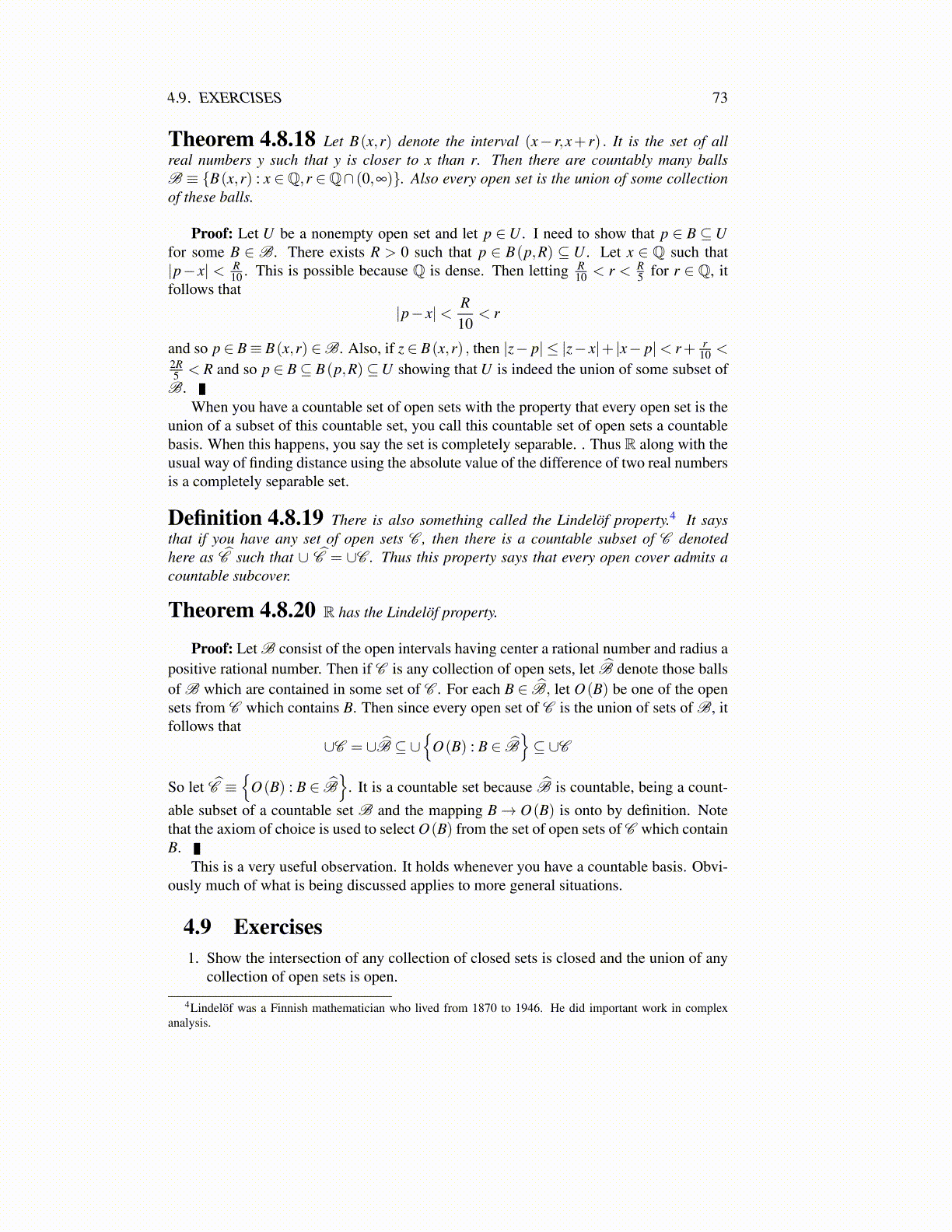
4.10. CAUCHY SEQUENCES AND COMPLETENESS 73
20. In Problem 19 in the case where the middle third is taken out, show the total lengthof open intervals removed equals 1. Thus what is left is very “short”. For yourinformation, the Cantor set is uncountable. In addition, it can be shown there existsa function which maps the Cantor set onto [0,1] , for example, although you couldreplace [0,1] with the square [0,1]× [0,1] or more generally, any compact metricspace, something you may study later.
21. Show that there exists an onto map from the Cantor set P just described onto [0,1].Show that this is so even if you do not always take out the middle third, but insteadan open interval of arbitrary length, leaving two closed intervals in place of one. Itturns out that all of these Cantor sets are topologically the same meaning that thereis a one to one onto and continuous mapping from one to another. Hint: Base yourargument on the nested interval lemma. This will yield ideas which go somewhere.
22. Suppose {Hn} is a sequence of sets with the property that for every point x, thereexists r > 0 such that B(x,r) intersects only finitely many of the Hn. Such a collectionof sets is called locally finite. Show that if the sets are all closed in addition to beinglocally finite, then the union of all these sets is also closed. This concept of localfiniteness is of great significance although it will not be pursued further here.
23. Show that every uncountable set of points in F has a limit point. This is not nec-essarily true if you replace the word, uncountable with the word, infinite. Explainwhy.
24. In Section 4.8.4 generalize everything to Rp. In this case, the countable dense subsetwill be Qp. Also explain why (Q+ iQ)p is countable and dense subset of Cp andwhy Cp is completely separable.
4.10 Cauchy Sequences and CompletenessYou recall the definition of completeness which stated that every nonempty set of realnumbers which is bounded above has a least upper bound and that every nonempty set ofreal numbers which is bounded below has a greatest lower bound and this is a propertyof the real line known as the completeness axiom. Geometrically, this involved filling inthe holes. There is another way of describing completeness in terms of Cauchy sequences.Both of these concepts came during the first part of the nineteenth century and are due toBolzano and Cauchy.
The next definition has to do with sequences which are real numbers.
Definition 4.10.1 The sequence of real numbers, {an} , is monotone increasing iffor all n, an ≤ an+1. The sequence is monotone decreasing if for all n, an ≥ an+1. Peopleoften leave off the word “monotone”.
If someone says a sequence is monotone, it usually means monotone increasing.There exist different descriptions of completeness. An important result is the following
theorem which gives a version of completeness in terms of Cauchy sequences. This isoften more convenient to use than the earlier definition in terms of least upper bounds andgreatest lower bounds because this version of completeness, although it is equivalent to thecompleteness axiom for the real line, also makes sense in many situations where Definition2.10.1 on Page 27 does not make sense, C for example because by Problem 12 on Page 38